Efforts of ESG in TOA
We have been focusing on environmental protection in the ocean for a long time. Our business, which started from the reclamation business in Tokyo Bay and has been engaged in domestic and overseas offshore civil engineering businesses, has a close relationship with the oceans. Starting in fiscal 2020, we will promote ESG-based management with environmental, social, and governance in mind, and contribute to the achievement of SDGs targets.
Contributing to Society through Infrastructure Development
As a leading company in port and marine civil engineering, we have also been involved in many areas such as restoration work in the event of a disaster and the development of disaster prevention infrastructure.
During the Great East Japan Earthquake in 2011, we leveraged our marine civil engineering technologies to contribute to the restoration of the Tohoku region, where the infrastructure was severely damaged. Here is a typical example. Kesen Ohashi, which is located at the entrance of the Kesen River, flowing within the city of Rikuzen Takada in Iwate Prefecture, which collapsed in the tsunami, is one of the main bridges on National Road No. 45 linking Sendai City and Aomori City. This bridge was severely damaged by the tsunami, causing major damage to the lives of citizens, industry, and the economy. We have therefore reduced the construction period by nearly three months from the initial schedule by utilizing our offshore construction technology by working vessels. Only three months after the start of construction, we opened a temporary bridge about 210 meters long, which contributed greatly to restoration and restoration. In addition to protecting the area from tsunamis and flooding damage, including Kuji Port in Iwate Prefecture, we were also involved in projects to develop bay-mouth breakwaters that improve the efficiency and safety of cargo handling operations. Thus, through our marine civil engineering business, which is one of our key businesses, we are contributing to SDG's "Creating a foundation for industry and technological innovation" and "Creating residential communities.“
Thus, through our marine civil engineering business, which is one of our key businesses, we are contributing to SDG‘s “Creating a foundation for industry and technological innovation” and “Creating residential communities.”First of all, we are currently building SEPs (Self Elevating Platform) in collaboration with Obayashi Corporation in order to respond to the domestic market for offshore wind farms, which is expected to expand in the future, and we plan to contribute to the promotion of offshore wind power generation in Japan by utilizing our technologies and experience.
In addition, we have developed the AR Navi navigation support system, which can be called the Maritime Version Car Navigation, as a safeguard measure for navigation of vessels in operation. Advanced technologies that utilize ICT enable us to promote the construction of robust infrastructure and to prevent marine accidents.
We have also developed the "Double Pipe Tremie Method," which greatly reduces the outflow of
pollution caused by sediment input, as an environmental measure in landfilling and
backfilling works dealing with sediment. Environmentally conscious, marine construction that
does not pollute the sea contributes to SDG's goal of 14 "Life below water.“
Our technological capabilities are also being utilized to remove sediment from water
bottoms, which contain dioxins and other harmful substances in sea areas, rivers, lakes and
marshes, and other areas, which have become even more serious environmental problems in
recent years. The Super Grab Bucket Dredging Method, developed by us, is an environmentally
friendly high-precision dredging method that enables soil and sand to be excavated and
disposed of while preventing the diffusion of hazardous substances into the surrounding
water. With the growing awareness of the environment around the world, we believe that
expectations for the technologies we have developed through our long-term construction will
grow even more intense.
As a leading company in port and marine civil engineering, we have also been involved in many areas such as restoration work in the event of a disaster and the development of disaster prevention infrastructure.
During the Great East Japan Earthquake in 2011, we leveraged our marine civil engineering technologies to contribute to the restoration of the Tohoku region, where the infrastructure was severely damaged. Here is a typical example. Kesen Ohashi, which is located at the entrance of the Kesen River, flowing within the city of Rikuzen Takada in Iwate Prefecture, which collapsed in the tsunami, is one of the main bridges on National Road No. 45 linking Sendai City and Aomori City. This bridge was severely damaged by the tsunami, causing major damage to the lives of citizens, industry, and the economy. We have therefore reduced the construction period by nearly three months from the initial schedule by utilizing our offshore construction technology by working vessels. Only three months after the start of construction, we opened a temporary bridge about 210 meters long, which contributed greatly to restoration and restoration. In addition to protecting the area from tsunamis and flooding damage, including Kuji Port in Iwate Prefecture, we were also involved in projects to develop bay-mouth breakwaters that improve the efficiency and safety of cargo handling operations. Thus, through our marine civil engineering business, which is one of our key businesses, we are contributing to SDG's "Creating a foundation for industry and technological innovation" and "Creating residential communities.“
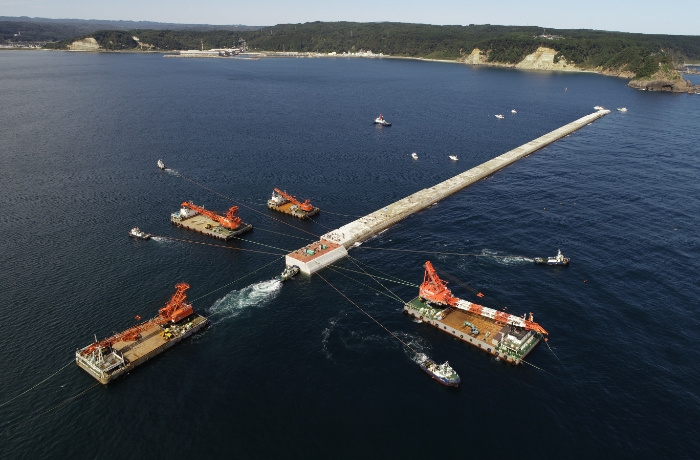
Involved in domestic and overseas port construction by leveraging our advanced technological capabilities
Thus, through our marine civil engineering business, which is one of our key businesses, we are contributing to SDG‘s “Creating a foundation for industry and technological innovation” and “Creating residential communities.”First of all, we are currently building SEPs (Self Elevating Platform) in collaboration with Obayashi Corporation in order to respond to the domestic market for offshore wind farms, which is expected to expand in the future, and we plan to contribute to the promotion of offshore wind power generation in Japan by utilizing our technologies and experience.
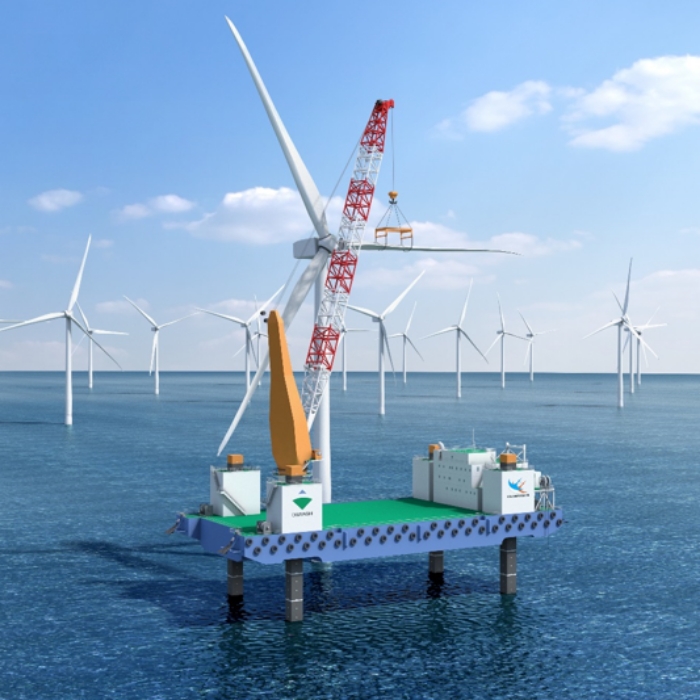
Image diagram of SEP
In addition, we have developed the AR Navi navigation support system, which can be called the Maritime Version Car Navigation, as a safeguard measure for navigation of vessels in operation. Advanced technologies that utilize ICT enable us to promote the construction of robust infrastructure and to prevent marine accidents.
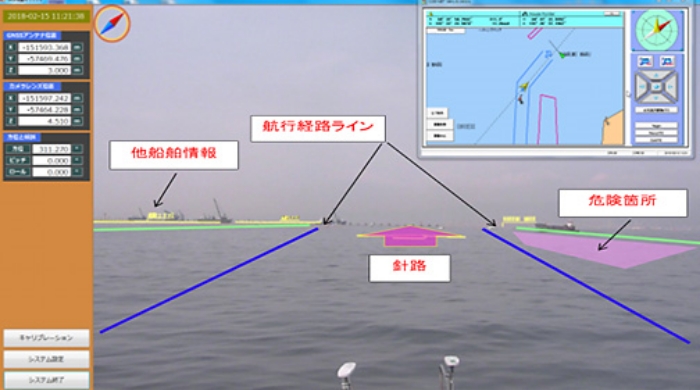
AR Navi System Screen
We have also developed the "Double Pipe Tremie Method," which greatly reduces
the outflow of pollution caused by sediment input, as an environmental measure in
landfilling and backfilling works dealing with sediment. Environmentally conscious, marine
construction that does not pollute the sea contributes to SDG's goal of 14 "Protecting the
Rich Sea.“
Our technological capabilities are also being utilized to remove sediment
from water bottoms, which contain dioxins and other harmful substances in sea areas, rivers,
lakes and marshes, and other areas, which have become even more serious environmental
problems in recent years. The Super Grab Bucket Dredging Method, developed by us, is an
environmentally friendly high-precision dredging method that enables soil and sand to be
excavated and disposed of while preventing the diffusion of hazardous substances into the
surrounding water. With the growing awareness of the environment around the world, we
believe that expectations for the technologies we have developed through our long-term
construction will grow even more intense.
Contributing to a recycling-oriented society through wooden architectural technology
In the architectural business, we are developing businesses that create social infrastructure
for the future, such as possessing construction technologies that meet the demands of the
times, including freezer warehouses with base-isolated structures.
Circular Economy,
which represents a recycling-oriented economy, is now drawing attention, but we have been
working to promote a recycling-oriented society in our architectural business, including
renovation of distribution facilities, hospitals, and large-scale facilities, and the
introduction of cogeneration and solar power generation facilities, since before this term
spreads. In recent years, we have taken advantage of our strengths to meet rising demand for
renovation while being environmentally conscious, by systematizing "in-situ construction,"
in which customers proceed with large-scale renovations while operating
facilities.
Currently, we are strengthening our efforts in wooden buildings. In Japan,
where forests account for two-thirds of the country's land, the recycling and utilization of
forest resources will lead to land conservation and the prevention of global warming.
Through the effective use of such forest resources, we aim to achieve a favorable cycle of
local production for local consumption of building materials, regional economy, and
environmental protection.
Wooden buildings are lighter in weight than ordinary steel structures of the same size, which also reduces CO2 during construction. Wooden construction is also said to have the effect of reducing human stress. We have been working on two hotels and other facilities in wooden construction so far, but we would like to continue making use of our wooden technology in a recycling-oriented society.
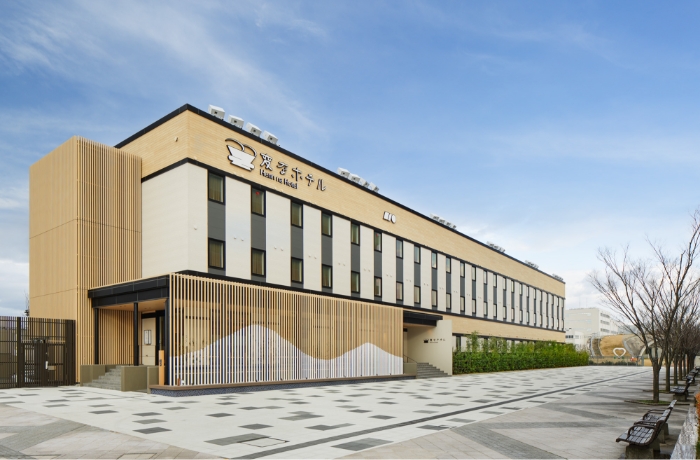
Hotels built with advanced wooden technology contribute to a recycling-oriented society
Realization of a society in which "no one is left behind"
Since we first carried out overseas construction in 1964, we have also focused on building infrastructure in developing countries, particularly in Southeast Asia. In recent years, we have been engaged in a number of projects, including construction of new railways and bridges, as well as port and harbor construction, which we excel in, as well as disaster prevention work for severe natural disasters. In order to respond to this international business, we are also focusing our efforts on the development of diverse human resources, such as increasing the number of foreign employees.
The International General Headquarters has established a working environment in which
employees can work regardless of their nationality and respond to the international society,
such as using the English language as an official language.
Our greatest strength is
human resources. Our distinctive feature is that even younger employees can challenge
responsible work, and that the company is well ventilated to hear the opinions and
suggestions of employees. I hope that we will continue to be a company that can contribute
to society for a long time by leveraging our advanced technological capabilities and "human
resources."
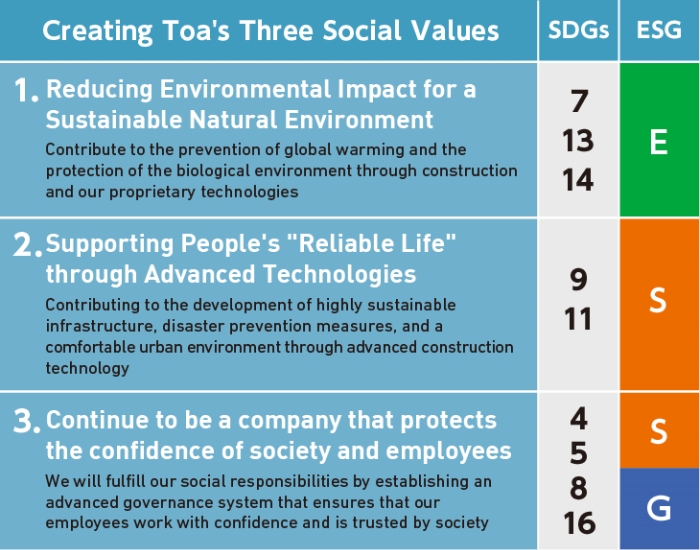
The creation of social value raised by TOA Corporation is also contributing to the solution of environmental problems.